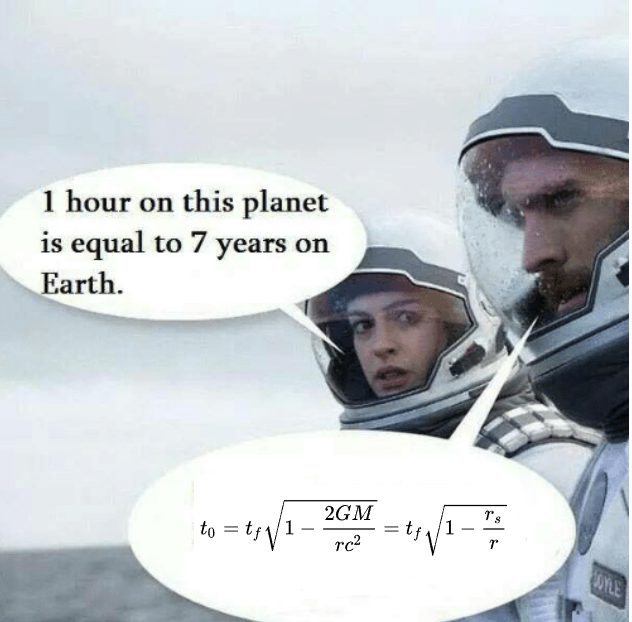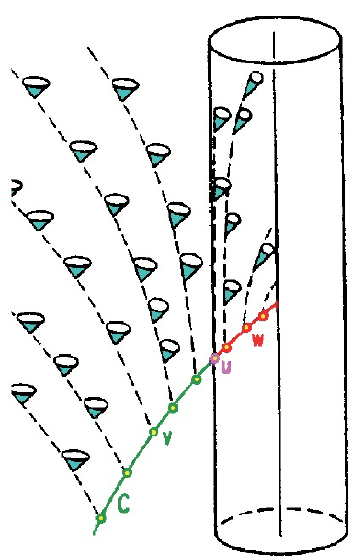Most common misconceptions in popular physics
Somewhere in an alternative Universe, based on MWI, I became a genius in physics. But in our Universe, I just read professional publications in physics, trying to keep myself up to date, meanwhile working as pizza delivery guy as DBA. Because of a slightly deeper knowledge of the subject it is almost impossible for me to watch the Discovery channel and other popular TV shows and the YouTube videos. I see nothing but oversimplifications, lies, and half-truths and can«t enjoy the shows.
I decided to compile a list of the most popular misconceptions. And the winner is…, or course, this one:
The Big Bang
Usually it is pictured like this:

That picture is usually followed by a sentence: «when the Universe was size of an atom…» Here there is a very important word missing: «When the visible Universe was size of an atom». Visible Universe is an area which can be (half)crossed by light since the moment t=0. In another words, it is sphere, with the boundaries, expanding at the speed of light (actually even faster). Of course, there are infinitely many such spheres with different centers.
Even more, if a Universe is spatially infinite now, it was spatially infinite from the very beginning (but there is some fine print here). Infinite and homogeneous. And that picture (and of course videos with the explosion) has nothing to do with the Big Bang. There is no point, where the explosion happened, throwing the material into the surrounding void. The more we go into the past, closer to the Big Bang, the more homogeneous the Universe was at that time.
And by the way, the theory of the Big Bang is NOT a theory about the Big Bang (t=0). It is a theory about what had happened after the Big Bang (t>0). That theory doesn«t answer the question about the origin of it. And even the name, the «Big Bang» was originally intended this to be pejorative, but the name was coined so well that now we all got used to it.
Black Holes
This is, probably, the major source of the misconceptions. Let«s start with the «Interstellar» movie:

So have such extreme time dilation a planet should hover at about 0.003% of the Schwarzschild radius. And based on how we observe the black hole:

The planet is at least at 10Rs from the event horizon. Let«s not even talk about the fact that such planet definitely is the worst possible candidate for a life-friendly planet for multiple obvious reasons. Of course, it is a movie and watching it we do a «suspension of disbelief» like we do when watching the Star Wars. We don«t judge the Star Wars for the sound of explosions in the vacuum. But the Star Wars had never pretended to be scientifically accurate, while the «Interstellar» team made bold claims that the scenario had been verified and approved by the scientists.
And to close the case of the «Interstellar», based on our current models of the black holes, there is no library inside them.
Time dilation inside black holes is infinite
This is an interesting case of a half truth followed by incorrect conclusions. It all starts from a correct statement that when a hovering observer approaches the event horizon, the time dilation goes to infinity. This is true. However, the following conclusions from it are incorrect:
- For an observer, falling into a black hole, time dilation is infinite
- Therefore he would see the far future of the external Universe, and the world outside would look accelerated to him.
- Falling observers are «frozen» near the horizon — because time is also frozen for them due to extreme time dilation
- One can jump into a black hole to reach these «frozen» observers, no matter how much time had passed
- Even more, falling observers would never cross the event horizon, as it would take an infinite time
- Even more, as nothing can fall into a black hole, we can conclude that black holes can«t form at all — it takes and infinite time for matter to collapse.
All these conclusions are derived from the very first one in that list, which is incorrect. However, intuitively it sounds so obvious that in the beginning of the XX century it confused a lot of scientists. So, we have a sequence of points hovering closer and closer to the horizon, and the time dilation goes to infinity when we approach it, and as when you fall to a black hole your trajectory crosses all these points, your time dilation also goes to infinity! Correct? No.
Time dilation is a property of a trajectory, not a point in space. So, what is true for a hovering observer (with a world line parallel to the horizon) is not true for a falling observer. Even Einstein himself was not able to find a complete solution of the equations of General Relativity covering not only volume outside the horizon, but also the inside because of the infinities at the horizon. The progress was made with a mathematical trick to switch to different coordinates. Intuitively it was based on the idea of using a «rain», freely falling into a black hole. There are many coordinate systems which avoid the problem with the infinity at the horizon.
Even more, based on the analysis it became clear what is called now a «No Drama» — for a freely falling observer nothing special happens on the event horizon, no disturbing music, no green flashes, no sparks from the equipment.
For more details about these coordinate systems you can start from Eddington–Finkelstein coordinates

That coordinate system is useful because you can answer most of the questions literally just by drawing some lines on that diagram and by moving your finger over it. Back to our list of misconceptions:
- Freely falling observer reaches the event horizon, and then the central singularity very quickly (he is falling almost at speed of light). If, close to the event horizon (but still above it) he changes his mind and puts engines into full reverse he would be crashed by enormous gravity it would take reeeeally long time for him to get back, and on his way back he would accumulate huge time dilation.
- When freely falling observer looks back to the Universe he left, for him it is slowed down and light spectrum is red-shifted. World outside is still visible even he is deep inside the black hole, but the view is squezzed into a small angle.
- «Freezing at the horizon» is nothing more than an optical effect
- One can try to catch up with a suicidal spaceship, decided to dive into Black hole a long time ago, but when you get close the horizon, the first ship «unfreezes», and you don«t find it near the horizon. If you ask an observer hovering close to the horizon, you are informed (in a very time-dilated manner) that the first spaceship had crossed the horizon «a long time ago», if hovering observer is aware of his own time dilation. Based on his own clock that time interval could be quite short.
- It takes an infinite time for a black hole to form — it doesn«t make any sense too.
Tidal forces rip everything apart close to a black hole
Based on calculations (we still need volunteers to test Young«s modulus of a human body), human body is ripped apart a fraction of a second before reaching a singularity. In terms of space, it happens few thousand kilometers away from singularity. For a stellar size black hole (20–30km) poor astronaut is torn apart far above the event horizon.
On the other hand, there are supermassive black holes, billions of solar masses in weight, with a radius about the size of the orbit of Uranus. In such black holes you have hours from the moment when you cross the event horizon to the moment when you die. In fact, you can fall into such black holes even without noticing it.
To get a black hole you need to squeeze a matter to extreme density
Again, it might be true, but only for small stellar size black holes. The radius of the event horizon is proportional to the mass of a body. And this is quite surprising, because one might expect something different: for the body with constant density the mass is proportional to the cube of radius.
Gravitational radius of our Earth is less than 1 centimeter. If we increase Earth radius by a factor of 10 (keeping density the same) such super-earth would be 1000 times heavier. Gravitational radius would grow by 1000, and the volume inside would increase by 1 billion (!!!) times. Now you must put 1000 times more matter into 1000 000 000 bigger volume, so we need to compress it 1 million times less.
Hence, increasing the scale of any body, we always get to a point where the gravitational radius catches up with the real one. Hence, we can make a black hole of any material without even compressing it — of water, gas, or even interstellar gas which fills the Universe. With an average density of our Universe the gravitational radius is about 10 billion light years.
This is a reason, by the way, why no static solutions of the Universe in General Relativity are possible — any static Universe, which is big enough, would become a black hole. But it is not the case for our Universe, as it is expanding, and the momentum counts in General Relativity.
To be continued…
